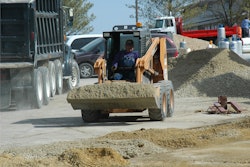
Generating a solid bottom line in the construction industry is about minimizing errors by managing risk successfully.
There is a financial rule of thumb that almost always holds true: risk and reward go together. The greater the risks you take the greater the rewards (or losses). Unfortunately that rule relationship doesn’t hold well for contractors.
In construction, risk seems to be aligned exclusively to loss. The more chances you take the more likely you will lose your shirt. The best advice I can give you is to view your role to be that of a risk manager. Generating a solid bottom line in the construction industry is about minimizing errors, i.e. managing risk successfully.
What types of risks must you manage successfully?
- The prices you offer
- The clients you work for
- The people you hire
- Production, safety, and quality
- Blown bids
- Blown schedules
- Equipment debt
- Financial mismanagement / theft
Which is your most important system for risk management? Your job costing system.
Job costing directly impacts your bidding, your scheduling and your crew’s performance. You must implement a sound, thorough and accurate job costing system. That means using the right tools to track field performance, a method for storing the field performance data, analyzing the data for trends, and incorporating the answers into your estimating and scheduling systems.
Over the last 20 years, I can count on two hands the number of commercial contractors I’ve met who had developed and deployed sound, thorough and accurate job costing systems. It is one of the first areas I look into when a contractor reaches out to me. All I need to see is a couple of filled out time cards to know whether their job costing system is remotely adequate or not.
The second most important system to perfect is your pricing. Yes, pricing is a system, if done correctly. The pricing system involves understanding the drivers of your overhead costs, your schedule availability, your competitor’s pricing habits and backlog, and how your risks vary by general contractor, design firm and real estate developer.
The third most important system is your staffing system. Your staffing system includes recruiting, interviewing, retention, compensation and reward/motivation techniques. You have to be able to entice talented workers to apply for openings. Your management team needs to know how to properly interview candidates so that you improve your odds of hiring hard working, trustworthy employees.
The second most important system to perfect is your pricing. Yes, pricing is a system, if done correctly. The pricing system involves understanding the drivers of your overhead costs, your schedule availability, your competitor’s pricing habits and backlog, and how your risks vary by general contractor, design firm and real estate developer.
The third most important system is your staffing system. Your staffing system includes recruiting, interviewing, retention, compensation and reward/motivation techniques. You have to be able to entice talented workers to apply for openings. Your management team needs to know how to properly interview candidates so that you improve your odds of hiring hard working, trustworthy employees.
You need to implement good leadership practices to minimize and/or eliminate turnover. Turnover wrecks business growth. Finding good field workers is always a challenge as they are almost always fully employed. Every time you lose a good worker your business regresses and your competitor’s strengthens.
Hand in hand with your staffing system is your management system. Everyone needs to be clear about their job duties, know what good performance looks like, know how their efforts tie to everyone else’s efforts to bring in projects on time and in budget. Job descriptions are a proven tool for aligning efforts. Your management system needs to provide training and development for your younger team members. Growing your own is by far the best strategy.
If you’ve read our special report on our website or been a newsletter reader for any length of time you are aware that we feel working for the wrong clients is the most common mistake contractors make. That is a risk you simply cannot afford to take.
Your market is flooded with prospective clients who will rob you blind if given half a chance whether they be the property developer or the general contractor. Leopards don’t change their spots. A client who has shown a history of taking advantage of contractors will do so in the future. Avoid risky clients. Don’t bid their work, and turn it down when they come calling. It really is that simple.
Another common risk taken is one that only can pay off if the planets align properly: landing a contract that is larger than your annual sales. Contracts of that size invariably pose three challenges.
Another common risk taken is one that only can pay off if the planets align properly: landing a contract that is larger than your annual sales. Contracts of that size invariably pose three challenges.
They create enormous cash flow problems. The project will likely demand you to staff up significantly. The project management tasks will place enormous pressure on your office staff. Unless you have already arranged for a credit line equal to 10% of the contract size, you will run short on cash early in the job and during the late stages of the job.
Your field crews are highly unlikely to be large enough and skilled enough to handle the complexity and pace of a big project. The volume of paperwork starting with contracts and running through change orders will shock your office staff.
The last two combine to produce field productivity which is much lower than your estimate planned on. That translates to cost overruns which greatly magnify your cash flow problems.
Furthermore, large jobs usually are won at less than desirable margins meaning that you have almost no room for error on the budget — which I just explained is going to turn out to be wildly optimistic once the final numbers roll in.
When your systems are humming, risk is minimized. Properly functioning job costing systems reduce the risk of blown bids. Smart pricing practices ensure you maximize your margins. Proper hiring techniques lead to a more reliable and predicable staff that works hard, safely and produces quality that you can take pride in.
I would be doing you a disservice if I didn’t mention a risk that all contractors intellectually acknowledge but behaviorally ignore: safety. Accidents are almost always avoidable. They are also relatively infrequent. Combine their infrequency with the discomfort of most safety equipment and the push to hit schedule milestones leads to excessive risk taking in the field. All it takes is one or two really significant injuries to drive your insurance modifier up to the point it wipes out much of your profit as well as putting you at a serious cost disadvantage over the next three years.
Running a construction business requires you to take advantage when the odds favor you and to keep your bets small when they don’t. A company that manages risk well is one that is going to stick around for the long haul. Be smart. Grow your business steadily and safely. In construction the tortoise wins the race.
When your systems are humming, risk is minimized. Properly functioning job costing systems reduce the risk of blown bids. Smart pricing practices ensure you maximize your margins. Proper hiring techniques lead to a more reliable and predicable staff that works hard, safely and produces quality that you can take pride in.
I would be doing you a disservice if I didn’t mention a risk that all contractors intellectually acknowledge but behaviorally ignore: safety. Accidents are almost always avoidable. They are also relatively infrequent. Combine their infrequency with the discomfort of most safety equipment and the push to hit schedule milestones leads to excessive risk taking in the field. All it takes is one or two really significant injuries to drive your insurance modifier up to the point it wipes out much of your profit as well as putting you at a serious cost disadvantage over the next three years.
Running a construction business requires you to take advantage when the odds favor you and to keep your bets small when they don’t. A company that manages risk well is one that is going to stick around for the long haul. Be smart. Grow your business steadily and safely. In construction the tortoise wins the race.
Finally, one of my favorite pieces of advice to share — which came from the book Good to Great — is "Be a hedgehog." Focus on what you’re good at and do get distracted by disconnected opportunities.




















